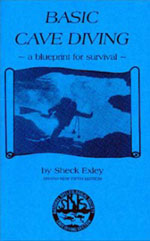| Penetration Diving on the Nullarbor Plain 1974 - 77 |
 |
| Written by Hugh Morrison |
|
Over the Christmas-New Year of 1973/74 the second Nullarbor cave diving expedition proceeded to dive in all the remaining wet caves except Winbirri, which couldn't be found. At this stage the divers were using only single tanks, 6 volt sealed beam lights and reels which could only be described as archaic. However, the two divers, Ian Lewis and Keith Deckers, were still able to add 1300 metres more to existing caves and, in particular, the spectacular Tommy Graham's system. Late in 1974 the first WA expedition, led by Hugh Morrison and Keith Dekkers, went to a total length of 500 metres in Cocklebiddy and pushed the Railway Tunnel of Weebubbie to a depth of 40 metres and total length of 400 metres. This expedition used twin tank systems with separate regulators on each bottle. The torches were still commercially available 6V types and reels were perspex with sinking 3mm nylon line which proved to be a problem throughout the expedition. August 1975 saw the second WA expedition once again at Weebubbie. However due to mechanical failure of the compressor very little was done except prove that the final rock pile in Tommy Graham's couldn't be negotiated. Equipment remained the same as previous trip, except the use of floating 3mm polypropylene line. This type of cord is the same as is used in all current trips.
A South Australian expedition early this year made the next contributionwhen they were able to add a further 350 metres to the length of Cocklebiddy and several hundred metres to Warbla. Cocklebiddy had proved to be a straight tunnel following a fault due north. The floor of the tunnel was in 13 metres while the roof undulated between 0 and 10 metres. It had ideal conditions for long penetration diving. Warbla had becomea phreatic maze thus leaving only Weebubbie with long unexplored tunnels. However Weebubbie was in water over 33 metres deep, thus creating problems of decompression and cold. This expedition had used twin sets yoked together with a single regulator and octopus. Radio detection finders had enabled them to pinpoint accurately various features of Cocklebiddy, and a 100 metre copper filling hose had solved part of the problem of conveying large numbers of tanks up and down the rock pile for filling. It had become obvious however, that Cocklebiddy was turning into another Mullamullang, only underwater. Almost immediately after the South Australians led by Phil Prust had returned from the plain, another West Australian expedition left. This group had developed the use of triple 72 steel tanks on a back pack using a regulator and contents gauge for each. An underwater sled had also been developed which was pushed along by divers. This carried 1200 metres of telephone cable and fifteen full cylinders along with a sealed tube containing clothes, food, extra batteries, ear phones for the telephone, etc., to enable a standby party to be comfortable at the large rock pile. Torches were used which had 2 independent power supplies to give extra life or extra power. The dive lasted 11 hours and the divers were able to add another 500 metres to the length of Cocklebiddy, thus making the total penetration approximately 2000+ metres. The dive at this stage remains the longest single cave penetration both in time and distance attempted anywhere in the world. All future expeditions to Cocklebiddy will have to plan for massive air consumptions and long dive tines, but the greatest problem to be encountered is the psychological problem of isolation and distance from safety. No amount of training or backup in terms of gear failure can compensate for e psychological failure. The best method of overcoming this isolation is to have large well trained groups with communication between divers and base camps. Without the full benefit of these aspects, any future group can't hope to add to what has already been done. Future innovations planned for the next assault include the use of underwater scooters, radio telephones without cables, smaller more manoeuvrable sleds and support parties camping 1000 metres in at the rock pile. It has become an exercise in planning and logistics, but unfortunately the frailness of human error is still very prevalent. Let me sum up by saying that no untrained or highly experienced divers should attempt to dive the Nullarbor, and that if you really wish to experience penetration diving of this magnitude, endeavour to join one of the organised expeditions from your state. I believe that there will be a death on the Nullarbor, but I believe it won't be from these well organised groups but from a transient visitor untrained in penetration cave diving. If this happens I know that the WA government will immediately move to close all diveable caves in WA, so ending true penetration diving in Australia. At all costs we mustn't let this happen. Presented at CDAA conference on cave diving - August 1977 |


